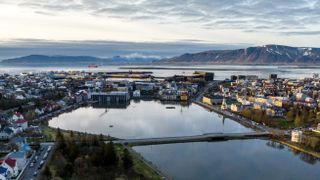Why Icelandic data centres are the 'greenest in the world'
The island nation has established its data centre industry over the last couple of decades and is seeking to fully reap the rewards of its sustainability credentials

Across Iceland, visitors can witness its rich, rugged landscapes, gaze in awe at cascading waterfalls, and even climb its icy glacier if they’re brave enough. This small island nation boasts of red-hot magma, rolling seas, and a luminescent flickering sky.
All of this attracts tourism, but there’s plenty more boiling under Iceland’s fiery surface. The country boasts an important resource vastly untapped by nations around the world – renewable energy – and the island’s technology sector is making full use. These energy sources have boosted the industry, especially when it comes to challenges posed by running energy intensive hardware processes like data centres.
On a recent visit to the land of ice and fire, IT Pro took a deep dive into the data centre scene, exploring how the nation hopes to position itself as a global leader.
With great power comes greatly reduced latency
Iceland runs on nearly 100% renewable energy which is sourced from domestic means. In 2020, Orkustofnun, the national energy authority of Iceland, revealed that 68.79% of the country's energy generation came from hydropower, 31.16% geothermal, 0.03% wind, and fuel accounted for 0.02%. This made up over 19 million MWh of electricity production in total.
Landsvirkjun, the largest energy generator in Iceland, is wholly owned by the public and operates 18 power stations on the island. It’s also recognised that Iceland has the ideal conditions for companies to set up sustainable data centres, even publishing guidance on its website.
The organisation really wants to emphasise the data centre sector, says Conor Byrne, business development manager at Landsvirkjun. Byrne believes that Iceland can offer potential data centre businesses some important benefits.

The stunning Pond City district in the Icelandic capital Reykjavík
Cloud Pro Newsletter
Stay up to date with the latest news and analysis from the world of cloud computing with our twice-weekly newsletter
One of these benefits is the availability of renewable energy, as well as the potential of energy capacity to grow. Landsvirkjun is looking at options to potentially expand its grid by 2030, where it hopes to get an extra 93 MWh of hydropower, 90 MWh of geothermal, and 120 MWh of wind power.
Another benefit is Landsvirkjun is able to sign commercial agreements with companies where it can commit supply to them over a long time period, at fixed prices. Byrne contrasts it with the way energy prices are spiking in the UK, with the price cap seeming to be reset every few weeks, producing a lot of volatility. In Iceland, companies are able to negotiate long-term agreements with fixed prices up to 12 years. “Obviously, from a business risk point of view, that's quite important, as an operator to have visibility, about what power prices, electricity prices you need to monitor,” says Byrne.
Iceland is also a stable, business friendly environment for companies considering different locations for data centres. He adds education levels are quite high, with a lot of people entering the tech sector – which has grown rapidly in recent years.
Moreover, the nation is also boosting its connectivity thanks to a new submarine cable under construction. Iris, Iceland’s third submarine cable, is set to be open in early 2023, according to Þorvarður Sveinsson, CEO at Farice, the nation’s publicly owned subsea cable operator.
“The government decided to start this project which is connecting Iceland to Ireland,” says Sveinsson, with the cable connecting Thorlakshofn to Galway.

2022 State of the multi-cloud report
What are the biggest multi-cloud motivations for decision-makers, and what are the leading challenges
Farice provides 100G and 10G wavelength services, IP transit, and ethernet services to its customers. Currently, data centres take up two thirds of Farice’s sold capacity while telcos and ISPs make up the remaining third. The latency between Reykjavik to London or Amsterdam is 18ms. Once Iris is fully installed, the latency will drop to 15ms, and will be 10.5ms between the Icelandic capital and Dublin.
The new cable will provide added redundancy in connection to Iceland. Additionally, Ireland might even offload high performance computing applications to Iceland, suggests Sveinsson, due to Iceland’s green power and attractiveness as a data centre powerhouse.
Looking to the future, Sveinsson says there is interest in establishing a 14,000km submarine cable connecting Japan to Europe via Canada, known as the Far North Fibre Project. This would be the first Arctic route connecting Asia with Europe through the Northwest passage. It could also connect Iceland to Asia, thanks to the Galway cable, giving the nation a route into a huge market. However, the project is still in the financing stage and is fairly ambitious.
Ship photons, not electrons
Icelandic data centres can underline their green credentials by comparing themselves to other markets. For example, power usage effectiveness (PUE), has been a hot topic for a very long time, says Gisli Kr, chief commercial officer of AtNorth, which has two data centres in Iceland, with a third coming soon. PUE is how much energy you’ll need on top of your server to cool the data centre, he explains, adding it’s a measure that’s king for customers.

AtNorth's CEO Magnús Kristinsson (pictured)
Part of the problem is that current data centre hubs in Europe are currently unsustainable, and are contributing to an increased carbon footprint, he explains. He refers to the “FLAP-D market” – Frankfurt, London, Amsterdam, Paris, and Dublin – claiming its data centre industry’s carbon footprint averages 292.2 CO2 grams per kWh. In the UK, meanwhile, the annual carbon footprint is 421.6 tons of CO2, which “is unacceptable”.
By contrast, the FINDS market – made up of Finland, Iceland, Norway, Denmark, and Sweden – averages a carbon footprint of 68.6 CO2 grams per kWh, nearly 80% lower than the FLAP-D hubs. These nations primarily exploit renewable energy, leading to a lower carbon footprint. Since the region has a cooler climate, too, less power is needed for cooling, which brings down PUE costs.
Kr adds, in some regions in Europe, there’s not enough power production, which has forced them to turn to external energy sources. One of these is the 1,400 MW NorthConnect underwater power cable between Scotland and Norway, which aims to connect their electricity grids. Kr says there’s an 8% loss of energy on the cable – around 112 MW of power. He outlines if it was a data cable, and there was an 8% loss of data, it would be unacceptable. Instead, he suggests moving the workloads from FLAP-D to the Nordics, and ship photons instead of electrons, so the data is closer to the energy sources.
Connecting two continents
Iceland’s optimal environment for data centres could transform the nation into a global hub in future, says Helgi Helgasson, managing director at Verne Global, although connectivity is the major pain point.
Verne is an Icelandic data centre company that opened its doors in 2012, and was the first big tenant of a former US NATO base, where its data centre in Reykjanesbaer was built. In September 2021, the firm was acquired by UK company Digital 9 Infrastructure.
Verne chose the location for its data centre in Reykjanesbaer as this area is geologically stable, enjoys a good climate for data centres, and has easy access to power. “We’re close to the airport,” Helgasson adds, “so that makes it easier for our customers to come visit us.”

Verne chose Reykjanesbaer due to its geographic stability and good climate for data centres
Despite enjoying accessible power, Helgasson’s challenges are those facing the wider industry, namely finding raw materials and equipment, and securing deliveries, which add to how much time it takes to build a data centre. He believes Iceland can serve as a hub for both the US and Europe, because it’s based between the two continents.
Despite Helgasson’s buoyancy, others disagree. Iceland’s data industry won’t necessarily be extremely big, according to Halldór Már Sæmundsson, chief commercial officer at Borealis Data Center. It will, nonetheless, be a pillar of the industry, and has great facilities and environment for certain kinds of workloads. This includes day-to-day high density workloads that don't require super low latencies. “I believe we will see the sector grow, but I don’t think it’s going to be sufficient to be really, really, huge,” says Sæmundsson.
The greenest data centres in the world
Borealis acquired a data centre in Reykjavik from Icelandic bank Íslandsbanki in mid-September, bringing its total number of data centres in Iceland to three. It seeks to operate efficient, low PUE, data centres using renewable energy, and focuses on the sustainable side for clients who want to reduce their carbon footprint.
It serves all kinds of customers, although tends to focus more on high performance computing (HPC), since the natural environment is perfect for that. “We also have regular colocation customers with their backup needs, disaster recovery, and we host some of the financial institutions locally as well as international customers,” explains Sæmundsson.

2022 State of the multi-cloud report
What are the biggest multi-cloud motivations for decision-makers, and what are the leading challenges
Most of Borealis’ customers are from overseas, especially the high density workloads and HPC workloads. The company has customers in Asia, Canada, and mainland Europe, for example. Borealis has also been building out its presence in Iceland exclusively. Its second data centre is located in the north of the country, near to a power station called Blanda hydropower station. Additionally, in this region, there’s no volcanic activity, no earthquakes, and the air is “absolutely perfect”, says Sæmundsson. He adds it’s one of the most secure locations in the country, too.
The data centre in the north has a different risk profile for its location. Different customer needs are being served through the additional site. It’s great for customers looking for high availability and security, he says, since its sites are spread over different parts of the country. Icelandic data centres, Sæmundsson stresses, are some of the greenest in the world.
“I think no other country can say that they have 100% renewable energy on the grid, and it's a closed-off grid; it's not connected to mainland Europe or other grids,” he points out, also highlighting the overall energy mix. The question over surging energy prices rears its head again, with Icelandic consumers and businesses benefitting from more predictability.
Iceland has a growing data centre industry that’s showing real green shoots. Many of the major players are hoping to attract more business from Europe, especially as energy prices on the continent rise, in contrast with Iceland’s cheap, stable and green energy provision. In the next few years, as data centre budgets struggle to stretch as far as they did before, the nation could be a tempting solution for many energy intensive processes like HPC computing. Plus, with the new submarine cable coming into play, Iceland might also prove itself a safe and secure location for companies to store their data.
Zach Marzouk is a former ITPro, CloudPro, and ChannelPro staff writer, covering topics like security, privacy, worker rights, and startups, primarily in the Asia Pacific and the US regions. Zach joined ITPro in 2017 where he was introduced to the world of B2B technology as a junior staff writer, before he returned to Argentina in 2018, working in communications and as a copywriter. In 2021, he made his way back to ITPro as a staff writer during the pandemic, before joining the world of freelance in 2022.





